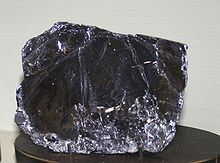- Molybdenite
-
Molybdenite
Euhedral molybdenite on quartz, Molly Hill mine, Quebec, Canada. The large crystal is 15mm acrossGeneral Category Sulfide mineral Chemical formula MoS2 Strunz classification 02.EA.30 Identification Color Black, lead-silvery gray Crystal habit Thin, platy hexagonal crystals terminated by pinacoidal faces, also as tapering six-sided pyramids that can be truncated by the pinacoids. Also massive, lamellar and in small grains in sulfide ore bodies Crystal system Hexagonal; 6/m 2/m 2/m Cleavage [0001] Perfect Fracture flaky Mohs scale hardness 1 - 1.5 Luster Metallic Streak bluish - gray Diaphaneity Opaque Specific gravity 4.73 Fusibility Infusible (1185 °C decomp) Other characteristics Thin cleavage sheets and crystals are flexible, but not elastic. It has a greasy feel and leaves marks on fingers Molybdenite is a mineral of molybdenum disulfide, MoS2. Similar in appearance and feel to graphite, molybdenite has a lubricating effect that is a consequence of its layered structure. The atomic structure consists of a sheet of molybdenum atoms sandwiched between sheets of sulfur atoms. The Mo-S bonds are strong, but the interaction between the sulfur atoms at the top and bottom of separate sandwich-like tri-layers is weak, resulting in easy slippage as well as cleavage planes.
Molybdenite occurs in high temperature hydrothermal ore deposits. Its associated minerals include pyrite, chalcopyrite, quartz, anhydrite, fluorite, and scheelite. Important deposits include the disseminated porphyry molybdenum deposits at Questa, New Mexico and the Henderson and Climax mines in Colorado. Molybdenite also occurs in porphyry copper deposits of Arizona, Utah, and Mexico.
The element rhenium is always present in molybdenite as a substitute for molybdenum, usually in the parts per million (ppm) range, but often up to 1–2%. High rhenium content results in a structural variety detectable by X-ray diffraction techniques. Molybdenite ores are essentially the only source for rhenium. The presence of the radioactive isotope rhenium-187 and its daughter isotope osmium-187 provides a useful geochronologic dating technique.
Semiconductor
Molybdenite flakes are a direct bandgap semiconductor with good charge mobility and can be used to create small or low-voltage transistors[1] possibly easier than graphene.
See also
- Molybdenum disulfide
- Powellite (calcium molybdate : CaMoO4)
- Rheniite
- Wulfenite (lead molybdate : PbMoO4)
References and external links
- Dana's Manual of Mineralogy ISBN 0-471-03288-3
- Mineralgalleries.com
- Webmineral:Molybdenite
- Mindat.org:Molybdenite
- Molybdenite Dating DEAD URL - Search doesnt find Molybdenite
Categories:- Sulfide minerals
- Molybdenum minerals
- Non-petroleum based lubricants
- Dry lubricants
- Hexagonal minerals
Wikimedia Foundation. 2010.



